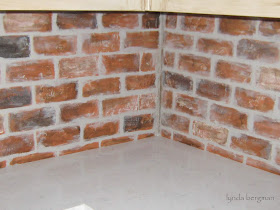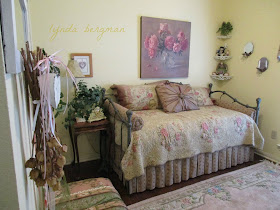HAND PAINTING A CHANDELIER & TUTORIAL
A few years ago, I painted the kitchen cabinets in my client's new home.
She wanted a darker, warmer tuscany finish. I painted most of the high walls and ceilings and textured and faux painted several of the walls.
A few weeks ago, she called and said she was ready for a change.
This time she wanted EVERYTHING to be painted in very light colors.
Because of my schedule, this time I only painted the kitchen cabinets and another painter painted all of the walls, ceilings and woodwork.
Back in the tuscany days, she painted this chandelier for her breakfast room in a very dark green to go with the tuscany feel of her new kitchen.
But, for her new lighter colors she purchased a fabulous huge chandelier for the kitchen and since this smaller one is in the same room, she wanted them to be similar in color. So, I painted, distressed and aged it with off whites and browny colors.
It looks really nice with her new colors and the new chandelier.
Those red lambrequin window treatments will be covered with new fabric. I saw some samples and they WILL be beautiful!!
My client does her own decorating and I love her taste. To me, it's artsy and unique.
In this picture, I had already started priming.
I almost forgot to take a picture of the "before" green.
It looks very different now, doesn't it?
And, here is her fabulous new chandelier. It might look small, but that's because her walls and ceilings are very high. This chandelier is 46" wide. It just "made" her kitchen. Her kitchen is large and cabinets spread out and the chandelier pulled everything together.
Very large and beautiful!
A close up of the finish on the new chandelier.
Next post I'll show you her "before" tuscany kitchen and then the new kitchen. They're very different, but both beautiful in her home.
PAINT A CHANDELIER TUTORIAL
Through the years I've painted lots of chandeliers.
When a client is changing her decor or if she just wants a change, it's sometimes easier and less expensive to paint than to replace. To replace you have to shop and purchase and then pay an electrician to install it, hoping he's able to get it right the first trip. It costs money if he has to come back. But, sometimes the wiring or other things need to be changed, thus prolonging that hourly charge. In home improvement I can do a lot, but for electrical and plumbing I always call a professional.
It's so much easier for me if they can bring the chandelier to my studio.
I just hang it from the ceiling, low enough for me to stand on the floor to paint.
Sometimes they're huge and I do need a ladder to work on them.
But, if I need to paint it in place in my client's home I do the same process that I would in my studio.
I just have to be more careful about covering everything around the area.
First, I dust or vacuum the best I can. Then, depending on the finish I will prime or just sand a tiny bit, very lightly. It can be very tedious, especially if there are a lot of crystal and other decorations. Then, you use a tiny or medium sized brush and start painting, distressing, aging, etc.
At the end, you need to make a decision about sealing the paint. Sometimes a sealer will change the dull look you wanted and make it shiny. Many times, I just use an eggshell paint or acrylic craft paints. They will dry to a hard finish. Nothing is going to be banging or hitting your chandelier, so it really doesn't need major protection. The main thing to remember is that with most painted surfaces, you need to be careful about using solvents because they can soften and remove the paint. If that happens, just touch it up. If you need to use a solvent on the crystals or glass, just spray your product on a cloth and wipe. If you keep it dusted, I think your finish will last a long time.
Make it beautiful!
Original post 9/14/14



















































